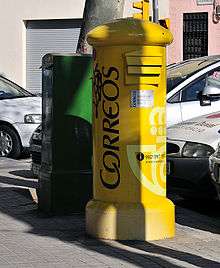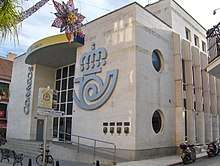Correos
Sociedad Estatal de Correos y Telégrafos, S.A., trading as Correos, is a state-owned company responsible for providing postal service in Spain and, due to bilateral agreements, it has responsibility for mail services in Andorra alongside the French company La Poste.
 Current Correos logo | |
_02.jpg) Correos main headquarters in Madrid | |
| Correos | |
| State-owned Sociedad Anónima | |
| Industry | Postal services, courier |
| Predecessor | Entidad Pública Empresarial Correos y Telégrafos |
| Founded | 1716[1] |
| Headquarters | , |
| Services | Letter post, parcel service, EMS, delivery, freight forwarding, third-party logistics |
| Owner | Spanish Government |
Number of employees | 53.065 (2018)[2] |
| Parent | SEPI |
| Website | www |
The origins of Correos dates back to 1716. The change of dynasty in Spain ended the tradition of giving to some relevant families the duty to take care of the postal services and, in July 8, 1716, King Philip V appointed Juan Tomás de Goyeneche as Chief Superintendent and General Administrator of the Postal Offices, making the postal service responsibility of the State.
The company is 100% state owned, through the State Society for Industrial Participations (SEPI). With more than 53,000 employees and 5.4 billion pieces of mail sent each year, Correos is one of the largest postal services in the world. Based in Madrid, it has over 10,000 postal centres all over Spain.
The Correos Group is currently integrated by Correos and its subsidiaries: Correos Express, the urgent postal service of the Group; Correos Nexea, a company that offers communication and document management services to other companies, and Correos Telecom, which manages the Group' telecommunication infraestructure.
History
One of the great developments in postal history during the nineteenth century was the invention of the postage stamp for the payment of shipments. The first stamps were issued in the United Kingdom, but many countries began soon after. In Spain, the first stamps was implemented on 1 January 1850, with face values ranging from 6 quarters for simple letters to 10 real for heavier certificates and international items. All stamps featured an image of the monarch.[3] The last step for the final reorganization of mail came in 1889 with the creation of the Body of Postal Workers, organized as a pyramid structure.
Coinciding with the reforms of the mid-nineteenth century liberal governments launched the telegraph service. Following the French example, Spain had developed a line drawing of optical telegraphy between 1844 and 1855, for the exclusive use of the State. From that date, was developing the electrotelegráfica network that joined in 1863 and all provincial capitals with Madrid. At the end of the century the number of telegraph offices open to the public amounted to fifteen hundred. This new system revolutionized the world of communications, reducing the time the message took to arrive to a few minutes.

Progress throughout the nineteenth century was consolidated during the 20th century with new technologies, new transportation, new services and a strong vocation of public utility caused the widespread use of email. The advent of the automobile and the airplane subsequently changed structures and accelerated postal delivery of correspondence and in 1899 the first post-road driving in the province of Navarra opened, and seven years later the central government in Madrid had already vehicle 16 for transporting the mail. In 1919 was created by decree in Spain the airmail service, which a year later created the first Spanish Airmail lines joining Barcelona Alicante and Málaga, Seville Larache, Barcelona and Palma de Mallorca Malaga Melilla. However, the railway remained the principal means of carrying letters and packages throughout the peninsula until 1993 when the train service gave way to transport by road of the model.
In parallel, Correos has been modernized through an ongoing process to provide new services throughout the century to citizens, such as express mail (1905), the Postal Savings Bank, on delivery reimbursement and Parcel Post (1916), the Postal Express (1981).
European projects
As part of its R&D initiatives, Correos is participating in several European projects, this includes:
- Leveraging eID in the Private Sector (LEPS).[4] Project developed through a Connecting Europe Facility grant (CEF Telecom) from September 2017 to November 2018. This project seeks to simplify the connection of private services with European public identification nodes (eIDAS nodes)
- Lightweight Infrastructure for Global Heterogeneous Trust management in support of an open ecosystem of stakeholders and trust schemes (LIGHTest).[5] Project developed through a grant Horizon 2020 (H2020) from September 2016 to September 2019. It aims to create a global infrastructure that facilitates the verification of trust in electronic transactions. Correos participates as an industrial partner, developing two pilots of its digital services that serve as proof of integration with the resulting infrastructure.
References
- "Sociedad Estatal" (in Spanish). correos.es.
- "Correos Integrated Annual Report - 2018" (PDF). p. 8.
- "Spain's first stamp: A classic that attracts specialists with modest budgets". Linn's Stamp News. Retrieved 2018-07-23.
- "Overview".
- "LIGHTest H2020 EU project".
External links
- Correos Website (in Spanish)
 A correos post office.
A correos post office.